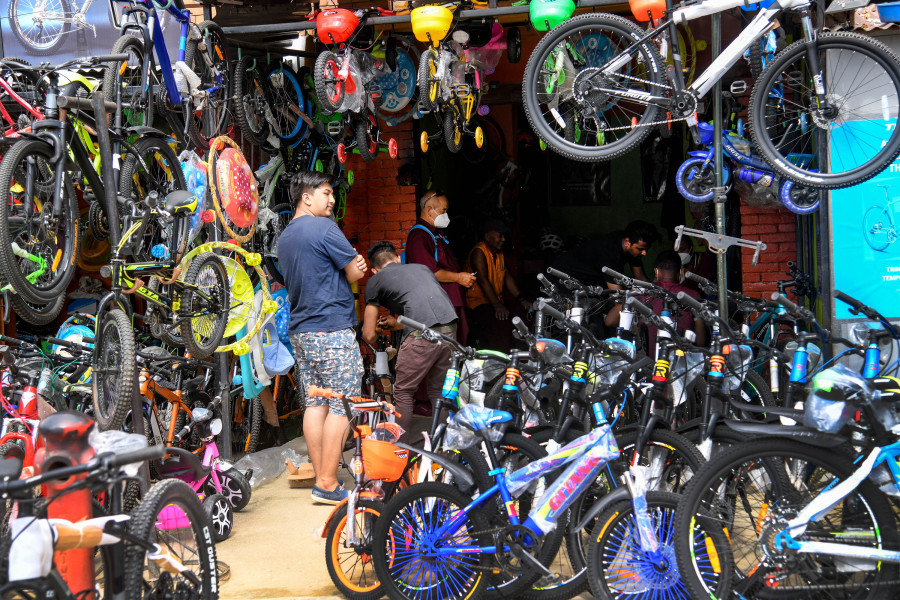Money
Bike sellers struggle to fulfil swelling demand amid the Covid-19 pandemic
Valley residents are rediscovering the good old bicycle as the virus limits their transportation options.
Tsering Ngodup Lama
Demand for bikes is so high that Himalayan Single Track—a Thamel-based mountain bike company that organises mountain bike tours and also sells and services bicycles—has already run out of stock.
“In the 11 years that I have been in this business, I have never seen such demand for bikes,” said Santosh Rai, managing director of Himalayan Single Track. “Not only did we manage to sell our new bikes, but we have also sold all our old stock of around 60 bikes that had been lying around for more than five years.”
Ever since the government eased the lockdown and removed restrictions on people’s movement, demand for bikes has skyrocketed, giving bike dealers a major boost in business.
The exponential increase in demand for bikes during the pandemic is not unique to Nepal. Globally, from the United Kingdom, Germany and India to the United States, many countries have seen demand for bikes soar during the pandemic.
When Pancbike, Nepal’s oldest bike store, reopened after the lockdown, the store’s phone wouldn’t stop ringing. Tirek Manandhar, the CEO of Pancbike, spent most of his time at the store answering customer queries over the phone.
Before the stay-home order, he used to get an average of two phone inquiries a day; but after the lifting of the lockdown, he has been getting an average of 15 calls a day.
“Suddenly, everybody in Kathmandu seems to want a bike,” he said
It was during the lockdown that Deepak Limbu decided to get himself a bike. Before the lockdown, Limbu used public transportation to travel in the city. “Given that we are living in the midst of a pandemic, travelling in public vehicles is a risk I don’t want to take,” said Limbu. “After spending hours online researching different types of bikes, I finally got an idea on the type of bike that fit my requirement.”
In a way, the pandemic has provided people with all the right reasons to get into cycling. With social distancing becoming the new norm, people are avoiding public vehicles (which have been flouting safety protocols) and ride-hailing apps, both of which, by design, make social distancing almost impossible.
“For the many looking for an alternative to public transportation, bikes have proven to be a cost-effective and safe way of commuting,” said Rai. “Then there are those that have gotten into cycling for health reasons to boost their immunity to fight coronavirus infection.”
And there are a variety of bikes to choose from.
Bikes come in three large categories—normal, standard and branded. Normal bikes are mainly for city commuting, and they only have the most basic features.
Prices for these bikes range from Rs12,000 to Rs20,000. Standard bikes are mid-range bikes and they come in less advanced parts than the high-end ones, and prices range from Rs20,000 to Rs40,000. The branded ones are the advanced bikes that come with top-end features, and their prices start from Rs40,000 and go up to hundreds of thousands depending on the make and material used.
According to Manandhar, the bikes that are most in demand since the lockdown ended are those that fall under the normal and standard categories.
“We only have the more expensive models in stock. The rest have all been sold out,” said Manandhar of Pancbike.
The problem Manandhar and Rai are dealing with now is restocking their inventory so they can meet the high demand.
“Ever since the pandemic took hold, the global demand for bikes has gone through the roof. There’s just so much demand that manufacturers are struggling to supply, making it extremely challenging for stores like us to restock in time,” said Manandhar.
Last month, when Limbu went to bike stores hoping to buy a bike, none of them had the type he was looking for. “Most of them had high-end models that were way beyond my budget. One of the stores told me to come back after a month’s time. So I have no option but to wait,” he said
This is not the first time that there has been such a demand for bicycles in recent memory. During the border blockade of 2015, which caused a severe shortage of fuel, demand for bikes skyrocketed with people cycling for their daily commute, according to Manandhar.
During the fiscal year 2015-16, Nepal imported bikes worth Rs801.3 million, according to the Department of Customs.
“We had been very hopeful that the trend would continue in the future,” said Manandhar.
But to Manandhar’s disappointment, not everyone continued using their bicycles for their daily commute.
Sanjay Theeng was one of the many who bought a mountain bike in 2015. “During the months of fuel shortage, the bike was my primary mode of commute,” said Theeng. “Once when the blockade ended and fuel became abundantly available again, I started using my motorbike again, and except for a few times a year, I rarely took out my bicycle.”
While using bikes for daily commuting may not have taken off after 2015, biking for leisure did, and with each passing year, it continues to become more and more popular.
In 2018-19 Nepal imported bikes worth Rs1.5 billion.
“It is not surprising to see leisure biking become so popular. We are naturally blessed with trails that make leisure biking a great adventure activity,” said Rai.
Geographically, says Ratna Shrestha—president of the Nepal Cycle Society, a cycling advocacy organisation—Kathmandu is ideal for urban cycling. “It’s not a very big city, and the average person’s daily commute is around 10 km, which is easily doable on a bike,” said Shrestha. “Even weather-wise, with the city’s mild winters and summers, it’s perfect for cycling.”
But for those cycling daily in Kathmandu, the challenges are aplenty. “One of the major concerns of cyclists in Kathmandu is lack of dedicated cycling lanes, which makes cycling in the city difficult and a bit risky,” said Shrestha. The first dedicated bike lane in the Valley—a 4.7 km cycle lane from Kupondol to Mangal Bazaar—was inaugurated only last November.
Both Manandhar and Rai say that only time will tell whether the rise in demand for bikes courtesy of Covid-19 will create a fundamental shift in people’s mindset when it comes to cycling.
In May, when the government began easing restrictions on people’s movement, Theeng took out his mountain bike that had been gathering dust in his garage. “I realised that for the foreseeable future, the safest way to commute will be on my bike,” said Theeng. “I have been riding almost everywhere—to work, for grocery shopping and I have even gone on a few weekend cycling trips. I had almost forgotten how good it actually feels to cycle. With gyms closed, it is a good workout too.”
The bicycle boom has made many like Shrestha cautiously optimistic about the future.




 16.35°C Kathmandu
16.35°C Kathmandu















